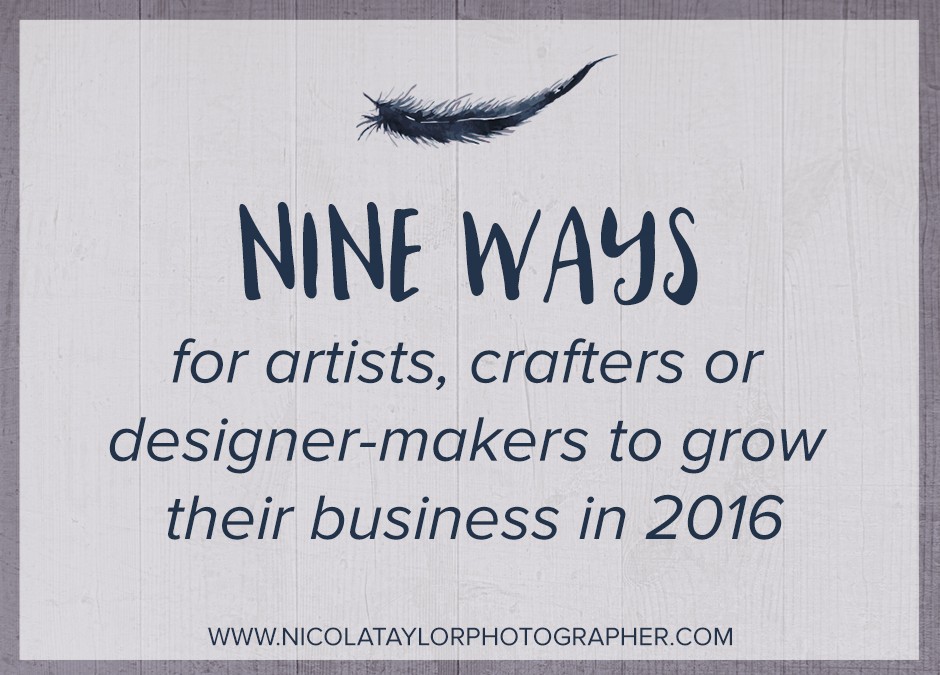Don’t make more New Year’s Resolutions you know you won’t keep. Try implementing one or more of these small changes and watch your creative business flourish in 2016
Take it into your own hands
Specifically, take the process of developing an audience for your work into your own hands.
Your audience is the single biggest asset that your business has. It’s the group of people who follow your work, whether it is on social media, or through your email newsletter, or by reading your blog or even by visiting a gallery that stocks your work.
It is incredibly important to the growth of your business that you own the information about your audience. Etsy, Folksy, Not on the High Street and galleries that sell your work are all great outlets, especially when you’re first getting started, but the buyers you accumulate through those sales are their customers and not yours.
If Etsy or Not on the High Street were to shut down tomorrow, (or kick you off the site) would half of your business shut down with them? If so, you really need to work on this in 2016. That means having your own website (with a store if possible) and an email list of your customers.
Don’t know where to get started with email marketing? Click here to download the January challenge from my 2016 planner and workbook The Maker’s Yearbook for free – it’s got a few quick and easy tips to get you on your way.
Systematise Everything
There are certain things you do very regularly for your business. Whether it is your monthly bookkeeping, pitching your work to a new shop, or preparing for a craft fair, these are tasks that you complete again and again and again and you wouldn’t believe how much time you waste just trying to remember the steps.
When I started creating a checklist for each of these types of tasks for my business, I saw a big increase in the amount of time I had available for taking photos.
It doesn’t have to be anything revolutionary – just a simple spreadsheet or word processing document will work.
For example, your month end process might look something like this:
- Enter all transactions into Accounting Software and Reconcile Bank Account
- Check Sales and Profits and enter into Spreadsheet
- Check Social Media Followers and Email Subscribers against targets and enter into Spreadsheet
- Follow up with Sale or Return galleries to see if extra stock needed.
- Back up all computers, website and Kashflow accounting software.
- Check on regular monthly expenses. Look for unused subscriptions or possible savings
- Review next month’s budget
- Review 2016 goals and reward yourself for any achievements
Create checklists for anything you do more than occasionally and soon you’ll wonder how you lived without them.
Put on your Artist Armour
Artists face a lot of rejection, all the time, and you have to be tough not to get disheartened by it.
It’s very difficult to run a small business and there are lots of disappointments along the way, but when the product you sell is made with your own hands and is extremely personal, any negative feedback can really sting.
Sometimes it is just people saying odd things and sometimes it is genuine feedback that could be helpful, if only it didn’t hurt so much.
Either way, it can really knock your confidence and there will always be a part of you that wants to stay hidden in order to stay protected from scrutiny. But, our businesses depend on being seen, whether it’s in person or on the internet, our customers have to be able to find us. And great things happen when we stop worrying about what other people might think or say.
That’s where the Artist Armour comes in. It’s an attitude that you can put on every time you’re feeling nervous.
Pitching to a shop you’d desperately love to stock your work? Entering that prestigious craft show you don’t really think you belong in? Submitting your work for that terrifying television show? Definitely time to put on your Artist Armour.
Warning: Artist Armour may cause greater confidence, more action, more opportunities, more publicity and more customers. It may also cause less worrying and fewer damns to be given. Use it wisely.
Dodge the Negatrons
We’ve all got one. Some of us have more than one. I’m talking about people who don’t really believe that it is possible to make a living as an artist and would like us to get a “real job.”
They might be your husband, your mother, your best friend. They might helpfully show you job listings or they might wonder out loud whether your “expensive hobby” is ever going to make a profit. They’re not bad people, but they are Negatrons and they need to be dealt with if you want to keep your head clear and able to focus on the things you need to do to grow your business.
In my personal experience, a direct approach has always been more draining than it is helpful. My best success has come from having a plan to dodge their questions.
Bottom line: Get to know their opening salvo and find a way to exit the conversation before they get any further. You may have to try several approaches before you find one that works consistently, but keep going. My favourite is the one word answer followed by a question about them.
For example:
“How’s business?”
“Great. Didn’t you just get back from holiday? How was it?”
The other way to neutralise the negative vibes is to surround yourself with like minded people. Whether in real life or online, there are other people in exactly your situation, struggling with the same problems you are struggling with. Facebook groups are a particularly good source of camaraderie and can lead to real life friendships too. Talk it through with people who really understand what you’re facing and keep your mum talking about tv and holidays.
Know where you’re going
There is a saying: “If you aim at nothing, you’ll hit it” and that’s as true with your art business as it is with anything else. It’s really important to set goals for yourself, and to revisit those goals on a regular basis. Aimlessness is definitely not a good business strategy.
So what kind of goals should you be setting?
I set myself goals for everything from how many new pieces of work I want to create, right down to how much I want to spend on materials, relative to my sales.
Don’t forget to review your goals regularly too. If I go too long without looking over the targets I have set for myself I tend to forget all about them and then wonder why I’m stressed and disorganised two months down the line.
I created The Maker’s Yearbook, my 2016 goal-setting workbook and planner, specifically for artists, crafters and designer makers, because one of my key goals was to spend more time creating images. I wanted to make sure I was staying on track with my marketing and financial goals so that I could get back to doing the thing I really loved doing.
Challenge Yourself
Monthly challenges can be a great way to focus on areas of your business that might normally get overlooked. Or if you’ve got lots of unfinished projects, setting yourself a challenge to finish one of them a month can help you to turn half finished work into something that’s out there and earning you money.
The Maker’s Yearbook has twelve monthly challenges to help motivate you to focus on an area of your business that you might be tempted to put on the backburner. Things like improving your product photography, refining your product range, assessing the profitability of your craft fairs and brushing up your product listings on all of your online marketplaces.
Make it a habit
Small changes, repeated over time, can have a very big impact on your business. The problem many of us have is that we go into a new year determined to change everything, all at once. New Year’s Resolutions are notorious for being extreme and punishing and most of us have had enough of them after a couple of weeks.
Try making small changes instead. Perhaps think about checking and responding to emails just twice a day, rather than being in your inbox all day. Or perhaps make sure that you spend two hours on making first thing in the morning, before you respond to any messages or phone calls. Or maybe commit to doing your bookkeeping once a week so it doesn’t get out of control.
All habits begin with some kind of trigger so make sure you set a trigger for the new habit that you are trying to establish. For example, if you want to begin doing your bookkeeping once a week, your trigger could be that it’s Friday at 2pm. And so, every Friday at 2pm you begin doing your bookkeeping (you could even set a phone reminder). Pretty soon you don’t even have to think about it. When it gets to 2pm on Friday, you just know that you need to start your bookkeeping.
Once you have established a new habit (it generally takes about 3 weeks) then you can add on another small change, and repeat. You can really make very significant changes to your business by layering habits in this way.
Stop Looking the Other Way
This is a really big one. I can’t tell you the number of times I have stuck with a product or a marketing strategy that wasn’t really working, just because I didn’t really know what else to try. I have returned to the same shows and events, knowing that they were unlikely to work for me, just because I didn’t know where else to sell my work.
But in 2015, I chose “Professional” as my word of the year. I really wanted to start taking my business more seriously. And one of the things I did as part of that was to start behaving like a business owner would. We are all the CEO of our own businesses and we need to make decisions about how we spend our money, how we sell our products, how we market, how we set our prices, just like a business owner would.
A business owner would not avoid contacting a potential stockist because they were scared of being knocked back. A business owner would not continue going to a craft fair where they were losing money because they didn’t want other crafters to think they weren’t serious. A business owner would not continue making a product that wasn’t selling well because two customers said they would be disappointed if you didn’t make it any more.
These are the easy choices but there were so many more times when I asked myself what a business owner would do.
And the biggest one? As any viewer of Dragon’s Den knows all too well, a business owner knows their numbers. Off by heart. They know how much money they have in the bank, how much they owe, how much they sell in a good month, how much they sell in a bad month, how profitable each of their products is. They know their numbers.
Make sure you know your numbers. Off by heart. Review them regularly and set goals to improve them. Don’t bury your head in the sand.
Reward Yourself
So often we forget to congratulate and reward ourselves when we accomplish a goal. We love to berate ourselves when we fail but when we succeed there’s just…nothing.
Be sure to celebrate your wins. Find a small reward you can give yourself for accomplishing one of your goals – maybe a decadent afternoon nap, or a visit to an exhibition. You’ll be amazed what it can do for your motivation.


